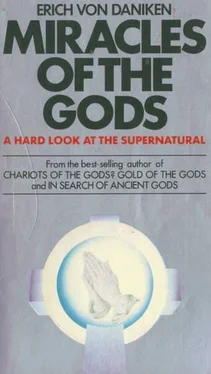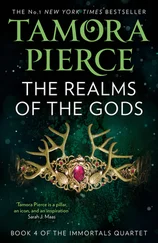Erich Daniken - Miracles of the Gods
Здесь есть возможность читать онлайн «Erich Daniken - Miracles of the Gods» весь текст электронной книги совершенно бесплатно (целиком полную версию без сокращений). В некоторых случаях можно слушать аудио, скачать через торрент в формате fb2 и присутствует краткое содержание. Жанр: Физика, на английском языке. Описание произведения, (предисловие) а так же отзывы посетителей доступны на портале библиотеки ЛибКат.
- Название:Miracles of the Gods
- Автор:
- Жанр:
- Год:неизвестен
- ISBN:нет данных
- Рейтинг книги:4 / 5. Голосов: 1
-
Избранное:Добавить в избранное
- Отзывы:
-
Ваша оценка:
- 80
- 1
- 2
- 3
- 4
- 5
Miracles of the Gods: краткое содержание, описание и аннотация
Предлагаем к чтению аннотацию, описание, краткое содержание или предисловие (зависит от того, что написал сам автор книги «Miracles of the Gods»). Если вы не нашли необходимую информацию о книге — напишите в комментариях, мы постараемся отыскать её.
Miracles of the Gods — читать онлайн бесплатно полную книгу (весь текст) целиком
Ниже представлен текст книги, разбитый по страницам. Система сохранения места последней прочитанной страницы, позволяет с удобством читать онлайн бесплатно книгу «Miracles of the Gods», без необходимости каждый раз заново искать на чём Вы остановились. Поставьте закладку, и сможете в любой момент перейти на страницу, на которой закончили чтение.
Интервал:
Закладка:
The psychotherapeutic effect of music too was well known to the Pythagoreans of the sixth century B.C. (I can hear the laments at Lourdes!) The Syrian philosopher lamblichus tells us: The Pythagoreans used music as a cure; and there were special melodies against psychic suffering, namely those against depression and anxiety, which were considered the most helpful - others against violent emotions and passions and against every kind of psychic confusion. In certain kinds of tones and rhythms, by which the disposition and mood of men is improved and their psychic state restored to its original state, Pythagoras found the means for pacifying and healing illnesses of body and soul.
How similar the two pictures are!
The miracles that saints and their adjurants perform today were performed by Asclepios and his disciples at Epidaurus with identical or similar methods, and without any Christian help!
Fortunately because it is demonstrable, those cured in classical temples also felt themselves obliged to express their thanks in a similar way to those cured at the shrines of visions and miracles. They, too, put up votive tablets. In A.D. 165 the Greek writer Pausanias from Magnesia in Asia Minor stood before the ruins of Epidaurus. In the second volume of his descriptions of Greece (Periegeses tes Hellados), he observed: In olden times there were even more inscribed plaques within the enclosure of the sanctuary than there are today. Now there are only six left. On them are recorded the names of men and women who were cured by Asclepios, and also the diseases which each of them suffered from, and how they; were cured.
The tablets are written in the Doric language.
During excavations at Epidaurus in 1928 these six stone: tablets were found, with the following messages of thanks: Ambrosia of Athens, one-eyed. Came to intercede with the god. When she walked about the sanctuary, she laughed at some of the cares and thought it impossible that lame and blind people could become healthy when they had only a dream. After she had slept in the cure room, she came out cured.
Euhippos has had a lance point in his jaw for six years and slept in the cure room. ... When day broke, he came out cured, with the lance point in his hands.
Hermodikos of Lampsakos, crippled in body. Asclepios healed him when he slept in the cure room and ordered him when he came out to bring the biggest stone he could find to the sanctuary. Then he brought the stone that now lies in front of the sanctuary.
Alketas of Halieis.He was blind and slept in the sanctuary. When day broke, he came out cured.
Arate of Laconia, dropsical. Her mother slept for her, while she herself was in Lacedaemon, and had a dream. ... When she returned to Lacedaemon, she found her daughter cured; she had had the same dream.
Aristokritos to Halieis. He had swum out to sea and while diving reached a place from which there was no way out. So his father, as he could not find his son anywhere, slept in the cure room of Asclepios....
When he came out of the room ... he found the boy on the seventh day.
The people who were miraculously cured 500 years B.C. behaved just the same as their counterparts today, and even the miracles were of the same quality as today, although the Christian guardians of
'genuine' miracles are not at all keen to hear that. The god Asclepios does not stand alone as the chief witness for pre-Christian miraculous cures; he is in illustrious company.
It is occasionally forgotten that Apollo was not only the god of radiant youth, poetry and music, but also the god of medicine and soothsaying ... and the son of Asclepios. So he had been well trained.
Apollo was a venerated god of healing, to whom a temple was erected in the sanctuary of Delphi in the eighth century B.C. Naturally miracles happened in it. The dumb learnt to speak. Kidney-stones disappeared through the ureter in a mysteriously natural way. Shiny-headed Greeks prayed and hair grew luxuriantly on their pates[25]. (A clever speculator told me that after the invention of knitting needles and the zip fastener, there was only one invention left that could make anyone a millionaire - a genuine hair-restorer. Prayers to Asclepios and Apollo cannot be sold as cosmetic miracle workers by the most talkative Figaros in the world.)
In the great sanctuaries of Thebes, the Egyptian city of the Dead, the god of healing, Amphiraos, was worshipped - in the temple of Ptah at Memphis votive stones were found on which cured patients extolled their gods. Frequently feet, legs and hands were perpetuated in stone to make their gratitude permanent. 376 stone ears were carved next to the image of the Ptah at Memphis [26]. A polycliaic for otology (ear therapy) must have been working overtime on miracles there.
Group experience is common to all these classical places of healing. I see in them predecessors of the psychodrama practised today in the sense in which Dr. Samuel Wamer [27] describes group therapy: Group therapy is often especially helpful, for it is easier to recognize something mutually, and during the reciprocal relationship one hand washes the other so to speak. ... This therapy is not only an intellectual experience; it also embraces the emotional life, for personality is formed by emotional experiences which are caused by the reaction of the glands and other subsidiary corporeal symptoms.
In order to achieve a basic change of personality the therapy must make contact with these intensive, repeated and continuing emotional experiences, so that the emotional spheres of the personality are affected again and undergo a tran-formation.
This kind of group experience with a deliberate goal could be sensed at all the places of pilgrimage I visited. The longing for a miracle - as a common emotional experience - released among complete strangers reciprocal relationships which extinguished any inhibitions, even against crying and lamenting aloud. People who were normally rather introverted underwent a change of personality.
They surrendered themselves completely to the general feeling. Here, at the goal of their hopes, among the mass of anonymous sufferers a change in their attitude to their illness took place. It was now or never! At places of pilgrimage ecstatic emotions are the humus on which the apparently incredible can materialize.
In this connection I should mention briefly 'animal magnetism' which was practised by the doctor Franz Anton Mesmer (1734-1815). Mesmer looked his patients fixedly in the eyes and then by laying on of hands used the powers radiating from people for suggestive cures. The Catholic Church has canonized thirty-five chirotetes (layers on of hands). The English surgeon James Braid (1795-1860)
realized that there was no occult hocus-pocus about successful healing by this method. He christened it hypnosis (Greek, sleep). Mesmerism became a European scourge, because people who did not possess healing magnetic powers also did a roaring trade in it.
We can read in a report [28] published in 1784 the extent to which mass suggestion and mass hypnosis could effect 'miraculous cures': The Marquis of PuisSgur had turned his chateau near Sois-sons into a 'magnetic sanatorium'. A fanatic follower of Mesmer's methods, he used it to house people in search of a cure. The afflux of patients was enormous: people were bursting out of the castle rooms. What could be done? The Marquis had a bright idea. He magnetized a stately elm tree in the village! 'suffering humanity from both sides of the Rhine flocked to this magnetic tree as if to a wonder-working sacred image'.
No comment. But reliquaries, mummified saints and miracle-working statues of saints are not always necessary to effect miraculous cures. Old elm trees can do it too so long as the cure seekers 'believe' in them.
Читать дальшеИнтервал:
Закладка:
Похожие книги на «Miracles of the Gods»
Представляем Вашему вниманию похожие книги на «Miracles of the Gods» списком для выбора. Мы отобрали схожую по названию и смыслу литературу в надежде предоставить читателям больше вариантов отыскать новые, интересные, ещё непрочитанные произведения.
Обсуждение, отзывы о книге «Miracles of the Gods» и просто собственные мнения читателей. Оставьте ваши комментарии, напишите, что Вы думаете о произведении, его смысле или главных героях. Укажите что конкретно понравилось, а что нет, и почему Вы так считаете.











